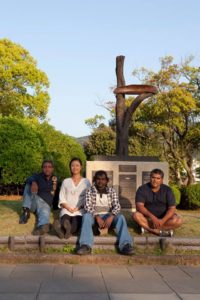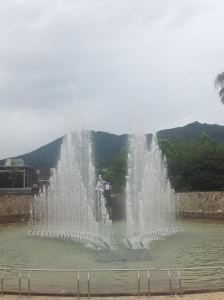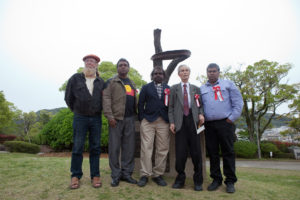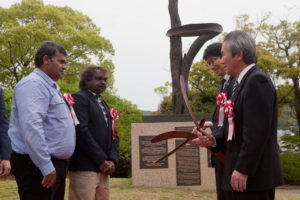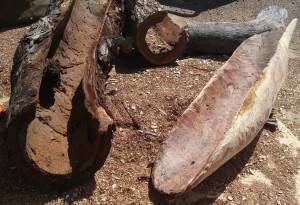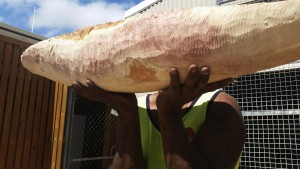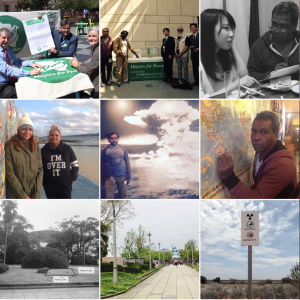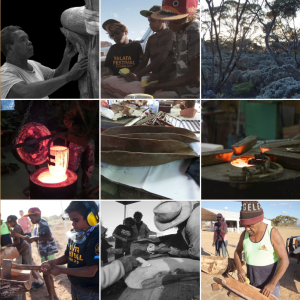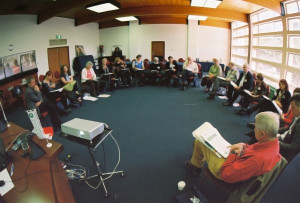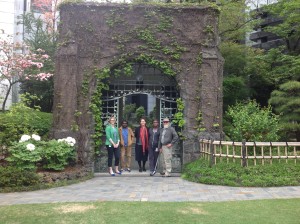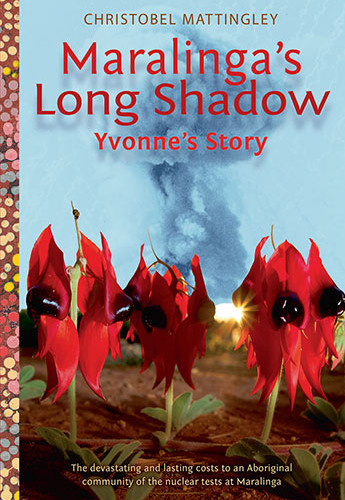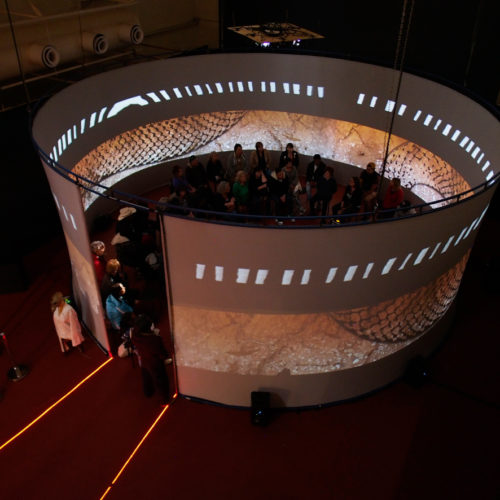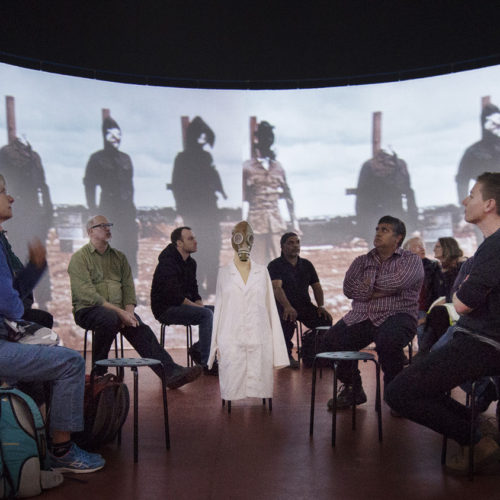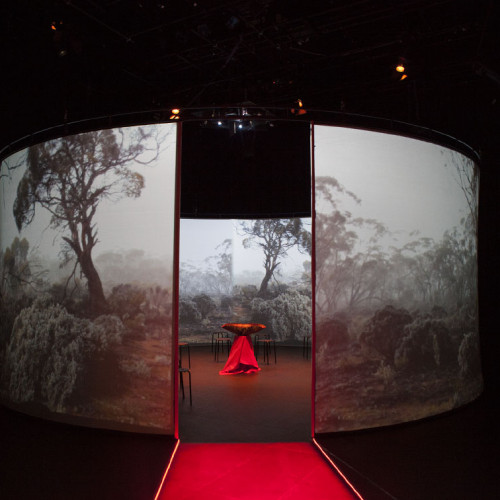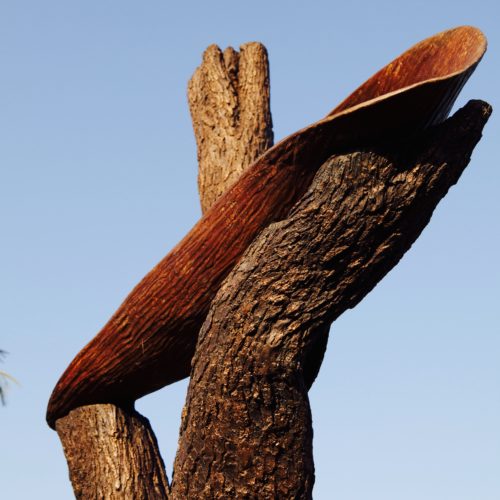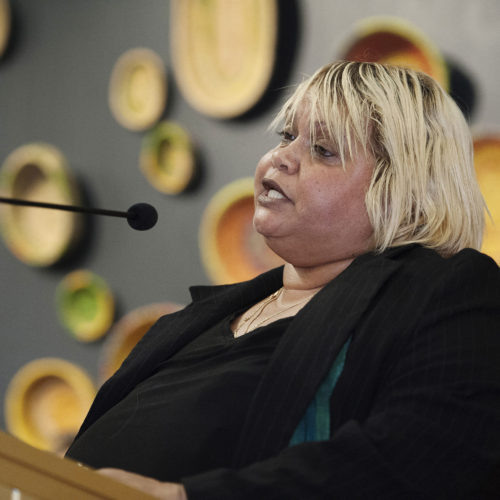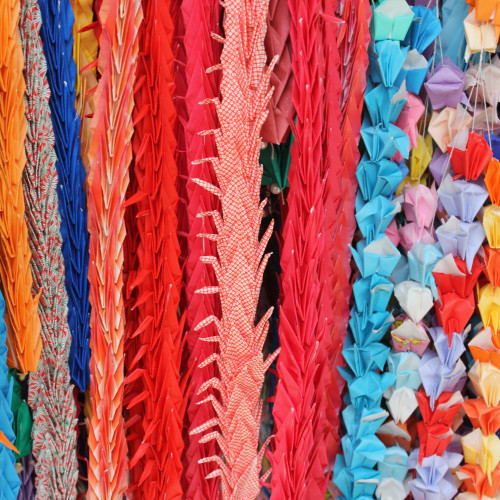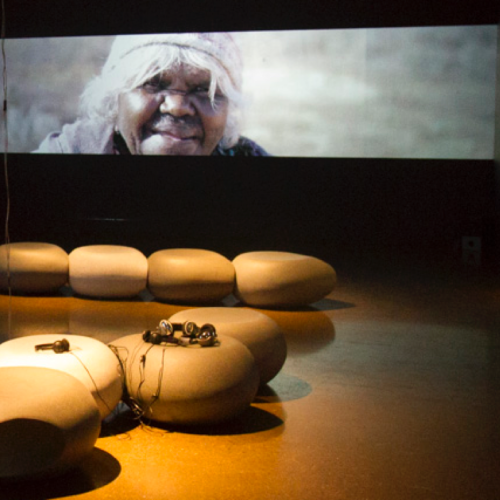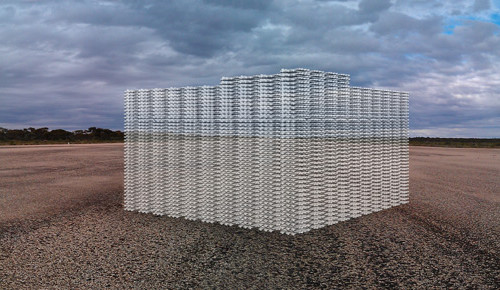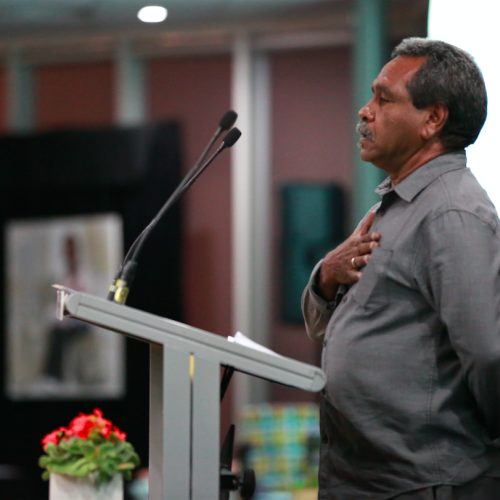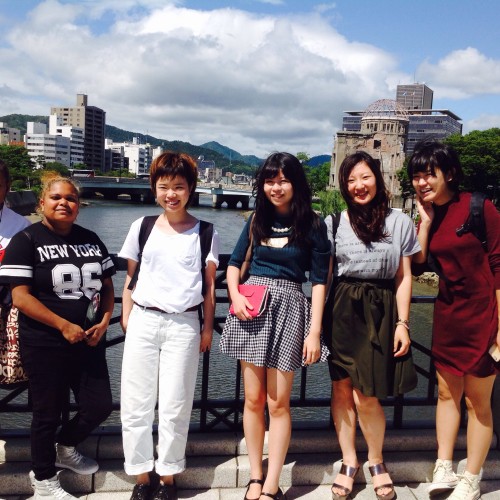-
Maralinga's Long Shadow: Yvonne's story wins NSW Premier's Award
- 8 years ago
- The annual NSW Premier's Awards for History, presented in Sydney on Friday 1 September 2017, saw one of our partnership projects honoured, when "Maralinga's Long Shadow: Yvonne's Story" took out the Young People's Hi[...]
Sculpture gift- Nagasaki Peace Park
In recognition of atomic survivor communities worldwide, this Indigenous gift is the first Australian sculpture contribution to the internationally renowned Nagasaki Peace Park. The sculpture originates from Yalata (far west South Australia), a community affected by British-led atomic testing in Australia, gifted in partnership with Mayors for Peace Australia.
Tree of Life: Gift of Peace
“The wind can blow an idea away. But a sculpture holds that idea forever.” Keith Peters, Maralinga Tjarutja Council Chair The international sculpture gifting of an Australian contribution (gift of peace) to Nagasaki Peace Park was led by City of Fremantle (lead city for Mayors for Peace Australia) and South Australia’s Yalata Anangu community, coordinated by arts company Alphaville. It was inspired as a contribution to the peace-related activities taking place in Nagasaki during the 70-year commemoration of the atomic bombings in Japan. It was supported by Cities of Cockburn and Subiaco, Graham F. Smith Peace Foundation, and the Australia Council for the Arts.
Nagasaki Peace Park is an internationally renown sculpture park frequented by thousands of visitors annually, featuring gifted artworks from around the world that convey messages of peace and friendship to Nagasaki City. Prior to April 2016, there was no Australian presence in the Peace Park. Alphaville Creative Producer Paul Brown explains, “the Australian contribution conveys a timely message of peace to Japan’s atomic survivor communities, and represents the passing of a call for hope and peace across generations and across borders, sent as an internationally relevant message of peace from Australia to Japan”.
Reasons for gifting an Australian Sculpture:
- inspired by, and to pay our respects to, Japanese atomic survivor communities.
- to contribute to peace-related activities taking place in Nagasaki during the 70-year commemoration of the atomic bombings in Japan.
- to support international advocacy for peace, valuing humanitarian messages arising from the experiences of atomic survivor communities (Hibakusha), to particularly engage younger generations in discourse and action for peace.
- to provide an Indigenous Australian presence in Japan, and to recognize Australian atomic survivor communities and the forward-looking initiatives they have pursued.
- to issue a call for hope and peace across generations and across borders.
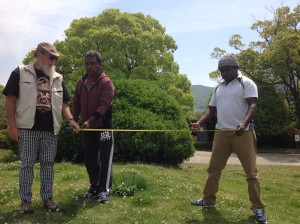
John Turpie, Steve Harrison and Russell Bryant during their April 2015 site visit to Nagasaki Peace Park.
For Australian communities, such as the Yalata Anangu Aboriginal community in South Australia, the project has created community development benefits and network opportunities within and beyond Australia. For both Australian and Japanese participants the gifting offered an innovative mix of opportunities for art-making, collaboration, exhibition and cultural exchange, as well as personal skills development and capacity building. The initiative links international peace-building and/or arts and cultural initiatives to promote local benefits and meaning. Click here for short background on the impacts of nuclear testing on Yalata community, and previous Media Releases about the project.
Gifting to Nagasaki Peace Park- April 2016
In the 12 months leading up to the official gifting Ceremony, the Australian contributing partners worked closely with Nagasaki City through a formal design and approval process. The Australian proposal was received positively by Nagasaki City and a prominent site was allocated on the central promenade of the Peace Park for the sculpture. The official gifting and unveiling of the sculpture was held on 18th April 2016. Click here to listen to a radio podcast featuring excerpts from the official gifting Ceremony and interviews with participants; and radio interview with artist Steve Harrison and creative producer Paul Brown here. The behind the scenes documentation process for the project can be viewed here.
Sculpture design:
The sculpture design is linked with an existing community arts sculpture project (with Alphaville and Nuclear Futures) being run with remote Indigenous communities in South Australia whose recent history relates to the British nuclear tests of the 1950s at Maralinga. In 2014 the Yalata men’s sculpture project was initiated to support local artists and community participation in arts activities. Across the several sculptures developed, the Yalata sculpture group’s focus evolved to depict the history of family migration, family life, and the search for peace and harmony, and to use sculptures to send ‘messages’ within community and to other atomic survivor communities in Australia and overseas. The sculpture project has been led by professional artist John Turpie via Yalata-based creative residencies. The group is responsible for designing the sculpture gifted to Nagasaki.
For the Nagasaki Peace Park artwork gifted, there is considerable meaning in the central sculpture and also in the process by which it is produced and gifted: a piti (dish) cast in bronze from original carved wood, will be placed as if cradled by the branches of a tree. Piti are used to carry food, water and other materials, and also serve as cradles for young children. The piti, as the central motif, represents the gift of peace, with the tree its ultimate donor. The sculpture represents the sharing of resources between families, communities and nations for peace and harmony. See Recent Post for more details.
Project Contributors:
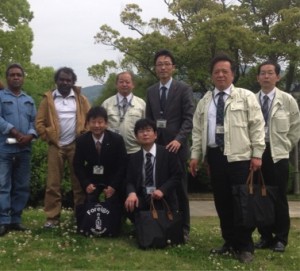
Site meeting with Steve Harrison and Russell Bryant (Yalata), and Nagasaki Peace Park officers, April 2015.
The initiative involves City of Fremantle as lead city for Mayors for Peace (Australia), Yalata Community Council, the Maralinga Tjarutja Council, Nuclear Futures program (Alphaville), and with support from the Australian Government through the Australia Council, its arts funding and advisory body, and the Graham F. Smith Peace Foundation, City of Subiaco and City of Cockburn. The project is not-for-profit and is administered by Alphaville. City of Fremantle representatives working on the project included Mayor Brad Pettitt and Mayors for Peace working group members Elizabeth PO’ and Adrian Glamorgan. The core creative team for the sculpture design included: Russell Bryant (Yalata men’s sculpture group), Steve Harrison (Yalata men’s sculpture group), John Turpie (artist in residence/ lead sculptor), and Tom Reeves (Bronze artist) and foundry team. Alphaville contributors included Nuclear Futures’ Paul Brown (Creative Producer), Ellise Barkley (Production Manager), Rico Ishii (Cultural Liaison and translator), Jessie Boylan (Photomedia artist/ documentation) and Linda Dement (Digital Media Designer).
City of Fremantle, lead city for Mayors for Peace (Australia)
The City of Fremantle joined Mayors for Peace a decade ago as part of a push from cities around the world to make sure nuclear disarmament is front and centre of the global agenda. In 2012, Fremantle became the lead city for Mayors for Peace (MfP) Australia. Part of the regional work by MfP (Australia) involves facilitating community-oriented peace activities and collaborating with organisations that promote peace. Of priority, is the dissemination of the humanitarian messages arising from the experiences of atomic survivor communities to engage younger generations in discourse and action for peace.
Watch video of Mayor Brad Pettitt speaking about the project.
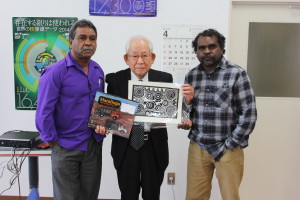
Cultural exchange between Japanese hibakusha (atomic survivor) representatives and Australian delegates.
Yalata Community
Yalata is an Aboriginal community on the far west coast of South Australia, 1000 kilometres from Adelaide by road. The people of Yalata are primarily Pitjantjatjara Anangu who descended from the desert people in the north and north-west of South Australia. Pitjantjatjara is the first language of the Anangu and English is a second language. Yalata is an atomic survivor community. Its families were resettled from the Maralinga Tjarutja lands prior to the British atomic bomb tests in the 1950s.
Alphaville (Nuclear Futures)
Alphaville is a Sydney based production company specialising in community arts projects that have environmental themes, working across local, national and international contexts. Previous projects led by Creative Producer Paul Brown have included Half a Life a verbatim play made with veterans of British Nuclear Testing, and Sixty Thousand Barrels a community engagement project, then an observational documentary film made with the Botany community about its struggle with toxic industrial waste.
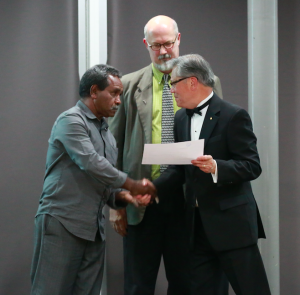
South Australian Governor (right) awarding grant to Steve Harrison (left) and Paul Brown (middle). Photo by Naomi Ebert-Smith.
Graham F. Smith Peace Foundation
The Graham F. Smith Peace Foundation (Peace Foundation) was founded in 1989 and aims to promote peace through the creative arts with a focus on human rights, social justice and environmental sustainability. On 23 October, 2015, community arts organisation Alphaville was announced as the 2015 winning recipient of the Graham F. Smith Peace Foundation’s $10,000 annual arts grant. The announcement was made at the Peace foundation’s yearly dinner at the Adelaide Entertainment Centre, presented by His Excellency the Honourable Hieu Van Le AO, Governor of South Australia. The annual Graham F. Smith Peace Foundation arts grant supports projects promoting peace, social justice and care for the environment. See Recent Post for more details.
Project Supporters via Crowdfunding
We would like to thank all the crowdfunding donors:
J.Levi, T. Jackson, C.Sammers, J. Barkley-Jack, A. Harwood, J. Vallentine, J. Eaglesham, L. Ebert, A.Harrison, M. Diesendorf, Z.I brahim-Mann, D. Collins, R&K Thomas, M. Deslandes, Womens International League for Peace and Freedom (WILPF) South Australian Branch, B. Frey, L. Graham, S. Jabbour, R. Tapper, J. Castle, S. Eglinton-Warner, L. Palmer, K. Hitchman, A. Crawford, Q. Goldfinch, N. Rowland, E. Wagner, M. Broderick, P. Graham, J. Mittmann, C. Daveson, Cr. J. Wilson, M. Fensom, J. Sammut, S. Miller, M. Maguire, N.A.J. Taylor, G. Kuiper, T. Jones, C. Phillips, J. Ferguson, K. Lecchi, A. Wilson, M. Fairskye, S. Deslandes, D.Boutagy, P. Ireland, N. Packer, M. Bailey, K. Hughes, E. Barkley, C. Hodgkinson, K. Forde, K.Coleman, M. Hughes, P. Murphy, N. Pothen, J. Gennissen, C. Janson, H. Klaebe, D. McCarthy, T. Goldstein, S. Cullis, E. Walker, C. Paterson, and all anonymous donors.
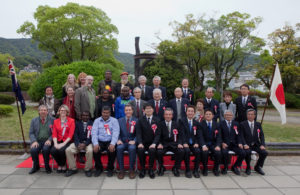
Delegates at the Official Opening Cerermony. 18th April, 2016, Nagasaki Peace Park. Photo by Jessie Boylan

Networking and exchange between international atomic survivor community representatives. Photo by Bo Jacobs.
